November 29, 2021
The webinar covered Michigan, California, Minnesota and North Dakota, Rocky Mountain and Nebraska.

On November 17, 2021, the U.S Dry Bean Council held their 2021 Dry Bean Harvest Overview webinar, which was hosted by the Executive Director, Rebecca Bratter and featured speakers Scott Bales, a Dry Bean Specialist at Michigan State University, Martin Squires, a grower and part of the California Dry Bean Advisory Board, Mitch Coulter, Executive Director of the Northarvest Bean Growers Association and Dave Weber, President of the Rocky Mountain Bean Dealers Association.
The webinar covered Michigan, California, Minnesota and North Dakota, Rocky Mountain and Nebraska, and finished with a Q&A session, which was led by Joe Cramer, Executive Director with the Michigan Bean Commission.
In her introduction, Rebecca touched on some of the factors driving demand, including the pandemic, an increased preoccupation with healthy eating, the rise of the plant-based trend, sustainability and the growth of the value-add sector, highlighting that these drivers are not likely to slow down any time soon.
Scott Bales covered Michigan, beginning by pointing out the excellent quality of the 2021 crop and indicating that the USDA is predicting a new state record for yields, although some irrigated acres did have less-than-average yields. He also mentioned the new varieties of black, navy and small red beans in Michigan and finished by affirming that the supply:demand ratio is good for 2021, although rising nitrogen costs may pose a challenge for 2022 seeding.
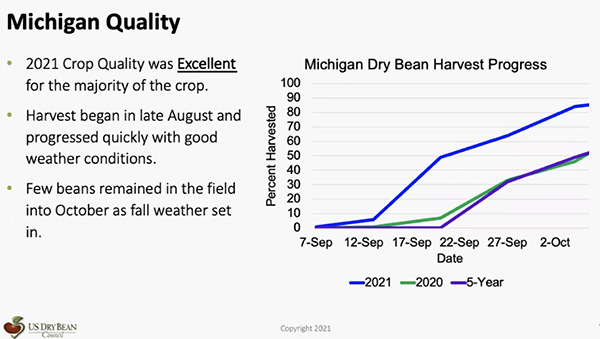
Image: USDBC
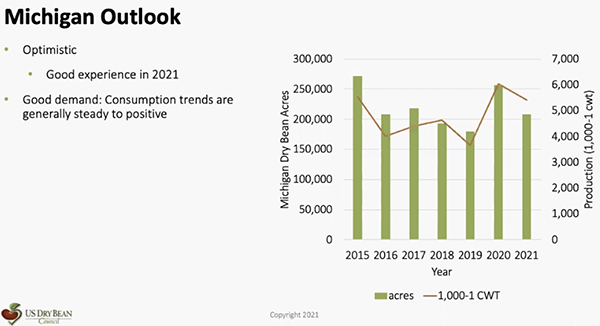
Image: USDBC
Martin Squires gave the overview of California, first reminding viewers that California acreage is down 40% due to droughts in the past few years although he reiterated that quality has not reduced. He indicated that quality reports for blackeyes, large limas and baby limas have been good and yields have been around average. He finished by saying that they hope to bounce back next year but challenges include inventory at planting time, water availability, purchase contracts and competition.
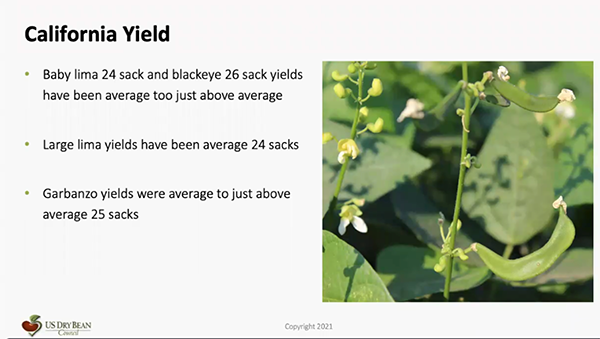
Image: USDBC
Mitch Coulter covered North Dakota and Minnesota, indicating that North Dakota saw a 150,000 decrease in planted acreage in 2021 due to strong competition from soybean, corn and wheat, high stocks and low seed availability. He also highlighted the increased demand for slow-darkening pintos in the state. He went on to say that the USDA predicts severely reduced yields compared to last year due to the drought, which affected the Western parts of the state the most. He also touched on stock levels, which are normal, and gave an overview of varieties.
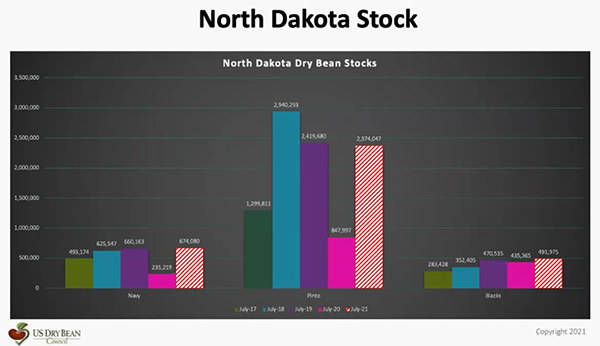
Image: USDBC
As for Minnesota, Mitch highlighted the slight decrease in planted acreage, for the same reasons as in North Dakota, and mentioned that kidney beans continue to be a driver in the state. He indicated that a high percentage (30%) of acreage being irrigated eased some of the drought issues and, along with late season rains, helped to improve quality. He mentioned that yields were average and disease pressures were low. Mitch also touched on stock levels, pointing out that all major classes of beans will have zero carryover in Minnesota.

Image: USDBC
Dave Weber gave an overview of the Rocky Mountain region, which represents 8 states of the US and grows a variety of beans. This year, he indicated, yields were average or above average,but both planted and harvested acreages were significantly decreased in Nebraska, Colorado and Wyoming. Pinto bean carryover is expected to be very small and Great Northern stocks, although higher, will likely be seriously reduced by USDA purchases. Corn prices, input cost and demand are expected to present challenges for 2022 planting.
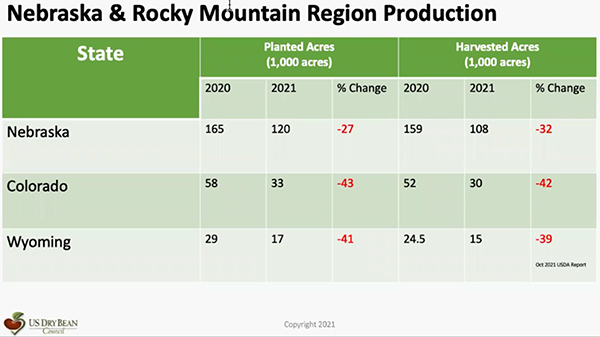
Image: USDBC
All panelists commented on the continuing logistics crisis and the particularities of each region.

US Dry Bean Council / Rebecca Bratter / Scott Bales / Michigan State University / Martin Squires / California Dry Bean Advisory Board / Mitch Coulter / Northarvest Bean Growers Association / Dave Weber / Rocky Mountain Bean Dealers Association
Disclaimer: The opinions or views expressed in this publication are those of the authors or quoted persons. They do not purport to reflect the opinions or views of the Global Pulse Confederation or its members.